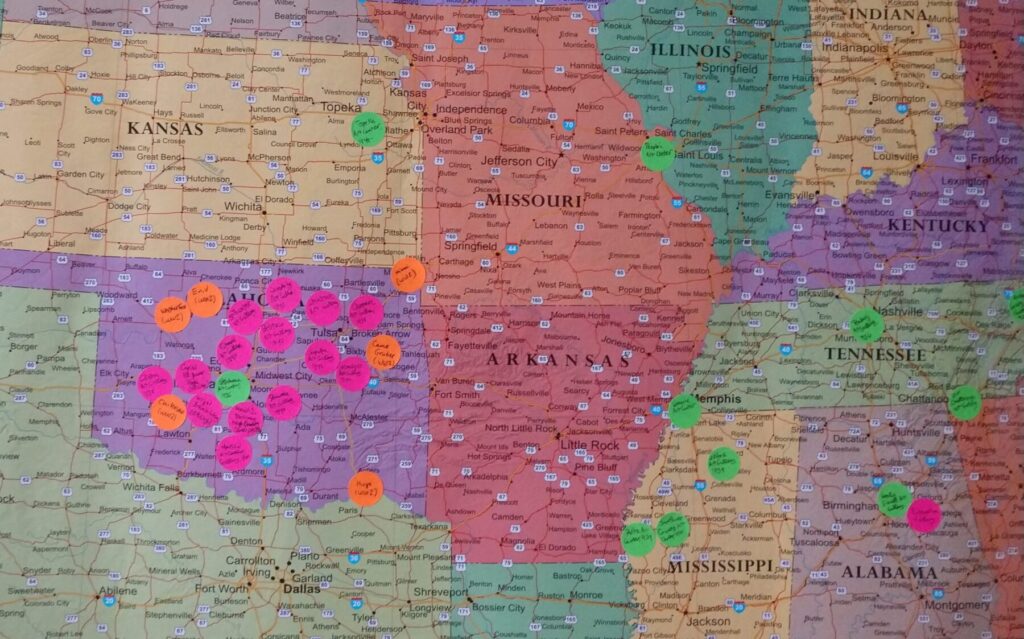The past few weeks have been somewhat peculiar for me. Since handing off my dissertation to my advisor in February, I’ve been in a holding pattern. For the first time in years, I don’t have any substantial work to do on the dissertation beyond technical minutae. That doesn’t mean I haven’t been doing dissertation-related work, however. On the contrary, I’ve been fulfilling one of my longstanding ambitions: mapping federal community art centers digitally.

Today, I’d like to share the new digital humanities project I just published: The Federal Community Art Center Initiative, 1935-1942. More than a map, this project is a repository for all I’ve learned about community art centers. Most importantly, it’s a calling card for other researchers interested in these important but understudied sites. It’s a digital space where we can all begin to collect our research. Let’s take a look!
Mapping Federal Community Art Centers: A Longtime Ambition
I’ve been wanting to map out the federal community art center initiative ever since I first started learning about it in the Roswell Museum archive. When I found out that our little museum in the middle of nowhere was part of a larger art-sharing initiative, I wanted to map its connections. During my first semester at William & Mary, I purchased a laminated map for my study, with stickers representing community art centers. As I learned about new sites, I added a sticker.

As helpful as this map has been in enabling me to visualize the program, I’ve never seen it as an end unto itself. It’s always been my objective to map the project digitally so that other people can access it. Dissertation writing, assistantships, curatorial work, and life itself have put this ambition on the back burner for a few years. After handing in my latest revision, however, I decided to follow through on my original plans.
StoryMaps: More than Mapping
One of the reasons why it took me so long to start mapping out community art centers digitally was that I wasn’t sure which platform to use. As much as I enjoyed Scalar for my Roswell Museum research, I found the map function buggy. ArcGIS seemed to be my best bet in terms of reliable mapping. Yet I also wanted a place where I could share all my research, from exhibitions I’d identified to individual artworks.
In the end, I opted for StoryMaps. While I did consider Omeka, I decided that my primary interest in mapping sites was a better fit for StoryMaps. Slideshows would enable me to share the other data I’d found.
A Call for Collaboration: Federal Community Art Centers
This project serves two functions. First, it’s a place where I can share everything I’ve learned about community art centers. While I’ve shared some data with other researchers over the years, this project puts everything in one place. Readers will see all the sites I’ve identified, Exhibition Section shows I’ve found, artworks I’ve matched with checklists, and more. It’s a repository for all my community art center research to date.




Yet for all the time and labor I’ve put into this project, like my physical map, I don’t intend it as the final result. In addition to documenting the work I’ve done, it’s an invitation for other researchers interested in community art centers. I can’t document this initiative by myself. There are simply too many sites in too many disparate places to visit them all, let alone get intimately acquainted with their archival records. The lack of time has only become more pressing since becoming Curator of Art at the Barry, where I have other obligations, projects, and priorities.
But I’ve also learned that I don’t need to do this alone. Over the years, I’ve met other people researching community art centers, and they are as passionate about them as I am. To me then, the best thing I can do is provide a space where we can share our research. As new information comes in, I’ll update the project and its map accordingly. Together, we can work toward creating a more comprehensive digital project.
Next Steps
This Storymap’s long-term goal, then, is to collect more research. To facilitate that, I’ve provided contact information where researchers can share their data. To get the word out about the project, I’ll be sharing it with my fellow community art center enthusiasts at the Living New Deal, GallupArts, and elsewhere so that they can circulate it within their networks. I’m also contemplating creating accounts for the project on various social media networks to reach a wider audience and attract new researchers.
In the meantime, if you have any information on federal community art centers, send an email to federalcacinfo@gmail.com. Together, we can all shed light on this important but understudied initiative.